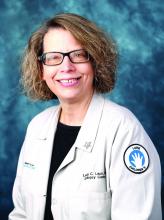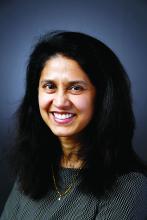CHICAGO – While neurologists treat children’s seizure conditions, you or an emergency physician usually sees the child first and must determine whether a seizure has occurred and how to proceed.
Knowing the characteristics of seizures – and their imitators – helps you appropriately evaluate and treat these children, said Sucheta Joshi, MD, of the University of Michigan, Ann Arbor, and Linda C. Laux, MD, the medical director of the Comprehensive Epilepsy Center at the Ann & Robert H. Lurie Children’s Hospital of Chicago. You also must consider the long-term management and well-being of a child with epilepsy.
“Although most children with epilepsy are followed by a pediatric neurologist, the primary care provider is an integral part of the epilepsy care team,” Dr. Laux explained at the annual meeting of the American Academy of Pediatrics.A primer on seizures
Abnormal electrical discharges in the brain cause seizures, and various acute conditions can cause them, including fevers, infections, trauma, and metabolic abnormalities. But an epilepsy diagnosis requires at least two unprovoked seizures occurring more than 1 day apart. More than two dozen different epilepsy syndromes exist, determined based on age of onset, seizure type, the child’s development, and EEG patterns.
You also should be aware of what seizure imitators to rule out: movement disorders such as tics and Sandifer’s syndrome, daydreaming and inattention, fainting, migraines, panic attacks, psychogenic nonepileptic seizures (PNES), self-stimulatory behaviors, periods of the child holding her breath, and sleep parasomnias, such as night terrors, sleepwalking, and sleep myoclonus.
“It’s often difficult to tell if it’s a seizure or a nonepileptic paroxysmal event,” said Dr. Joshi. An interictal EEG can be helpful, but “there’s no reliable test to differentiate the two.”
Knowing the environment where the incident occurred, what provoking factors might have been present, what the seizure looked like, how long it lasted, and what happened afterward can help you differentiate paroxysmal spells from seizures.
Febrile seizures
About 4% of all children experience febrile seizures, particularly between 6 months and 6 years of age, Dr. Joshi said. The two types are simple and complex. A simple febrile seizure is generalized and brief, lasting less than 15 minutes, and is not followed by another within 24 hours. The child may have a family history of epilepsy but appear normal. Complex febrile seizures are focal, last more than 15 minutes, and occur more than once within 24 hours.
Simple febrile seizures require no work-up other than determining the fever’s source. The risks of chronic antiseizure medications, such as phenobarbital or valproate, exceed their benefits and are not indicated for febrile seizures, even recurrent ones, she said. Further, no evidence supports any treatment’s ability to effectively prevent later febrile seizures or epilepsy after a febrile seizure.Although antipyretics may help the child feel better, fever control won’t always prevent seizures. Rectal or sometimes oral diazepam can prevent recurrent prolonged febrile seizures if necessary. You also may consider oral clonazepam as a rescue medication.
However, children with only simple febrile seizures are at no greater risk of developing epilepsy by age 7 years than are children in the general population, about 1%, according to the AAP’s clinical practice guideline for long-term management of children with simple febrile seizures (Pediatrics. 2008 Jun;121(6):1281-6.)
If a child has a family history of epilepsy, has their first febrile before 12 months of age, and has multiple simple febrile seizures, however, their risk of epilepsy more than doubles. An estimated 2.4% of these children will develop epilepsy by age 25 years.
“No study has demonstrated that successful treatment of simple febrile seizures can prevent this later development of epilepsy, and there currently is no evidence that simple febrile seizures cause structural damage to the brain,” the practice guideline states. “Indeed, it is most likely that the increased risk of epilepsy in this population is the result of genetic predisposition.”
Determining seizure causes
If the child’s seizure is not clearly febrile with a known cause, you should run through other possibilities. Did the child have head trauma? A central nervous system infection? Are metabolic abnormalities present, such as renal or hepatic disease or an electrolyte abnormality? Has the patient ingested something, such as a recreational drug or other toxic substance?
Lab work is unlikely to offer much information without clinical signs or symptoms present, but you may consider glucose, electrolytes, serum alcohol level, and a toxicology drug screen on a case-by-case basis: A child’s first unprovoked seizure should not lead to a lumbar puncture, Dr. Laux said. But if you suspect a CNS infection or the child is under 6 months old and does not return to baseline, you should consider a lumbar puncture. Modest increases in cerebrospinal fluid cell count (pleocytosis) occur after a seizure, but a “CSF above 20 WBC/mm3 or above 10 PMN/mm3 should not be attributed to a seizure,” she said.
An outpatient EEG, preferably performed within 24-48 hours, shows abnormalities 70% of the time after a seizure, but a normal EEG cannot rule out a seizure. EEG data also may suggest recurrence risk or a specific epilepsy syndrome and long-term prognosis.



